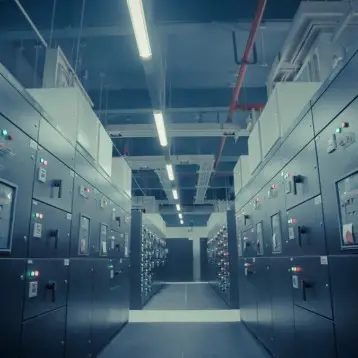
Listen to the full podcast on Cloud Inventory’s website: https://www.cloudinventory.com/podcasts/drive-value-with-cloud-inventory
Full Transcription below:
Welcome to Enterprise Radio, the signature show of the enterprise podcast network, featuring some of the most prominent business professionals in the world today. And now your host, Eric Dye.
Eric: This is Eric Dye, and once again, welcome to Enterprise Radio, part of EPN, the Enterprise Podcast Network today. We have the opportunity to speak with Kristi Robison, the vice president of customer experience at Cloud Inventory. As an established implementation leader, Robison joins us to talk about the value proposition behind Cloud Inventory and how it’s mobile first, cloud based inventory management technology delivers innovative solutions that achieve her customer-specific supply chain needs.
And Kristi, thanks so much for joining us here today on Enterprise Radio.
Kristi: Hey Eric, thanks so much for having me.
Eric: You’re certainly welcome. Thanks for joining us here today and for your time now.
For starters, how does Cloud Inventory help customers drive value in these challenging times? Let’s kick things off with that today.
Kristi: Sure. So in these times, it’s as important as ever to focus on the value derived from your technology investments. And here at Cloud Inventory, we are passionate about driving value for our customers.
Cloud Inventory customers realize the value from our solutions in four key areas. Those are productivity, compliance, inventory optimization and revenue generation. Cloud Inventory increases productivity by automating inventory processes and removing base manual processing.
We had one customer, a large sport apparel and equipment company, see a direct bottom line impact $300,000 in labor cost savings in the first year alone by using Cloud Inventory to fully automate their distribution center.
Another area where customers realize value is through increased compliance. Cloud Inventory provides the ability to track and trace products as they travel through the supply chain to the customer. So in heavily regulated industries such as food and beverage, having that solution that’s capable of tracking from the receipt of the raw materials through the product creation process and all the way to the finished product, ensures regulatory compliance and reduces write off costs due to recalls.
Next, inventory optimization, or having the right amount of stock in the right place at the right time, is another area where customers see the value in Cloud Inventory. If you aren’t proactively managing and optimizing your inventory, then your inventory accuracy is definitely going to suffer, and your costs are going to be higher. So by automating and optimizing inventory processes in Cloud Inventory, you have better visibility into your inventory, eliminating those inventory blind spots that we all have.
You’re also able to improve planning and forecasting, which will help you better serve your customers because you have real time inventory availability at the time a customer is actually placing their order.
And the last one, revenue generation, it’s ultimately a result from all the areas we’ve already covered, where you’re seeing the impacts to both the bottom line and top line revenue based on the improvements you’ve been able to make.
Cloud Inventory customers have been able to do things like add new products and customer experiences, thanks to the real time inventory, visibility and support that they get from our solution.
One of our customers, a brewing company with about 450 or so employees, they have expanded their product line to the point that their legacy warehouse management solution could no longer support it. So they implemented Cloud Inventory to manage their warehouses instead. And they were actually able to expand their warehouses and add additional product lines to meet the increased demand for their products.
Eric: That certainly is a great example, and I’m sure you’ve jazzed up the audience to pay closer attention to more information around Cloud Inventory and what you offer in the inventory management space.
Now tell us one of the most important steps in ensuring an optimal customer experience for Cloud Inventory’s customers. Talk to us about that.
Kristi: Well, Eric, one of the great things about the team at Cloud Inventory is that we’re always focused on answering the question — how are we making our customers’ lives better? So we’re constantly evaluating our customers’ journey and interactions with us from the first contact, to post go-live and beyond, to ensure that we’re meeting and exceeding our customers’ expectations.
Early in the engagement, we’ll work with our customers to understand their specific needs and pain points in their business so that we can match those up to the right Cloud Inventory solutions and help customers identify and quantify the business value that they can expect to achieve from implementing Cloud Inventory.
Another area of focus for us is our customer onboarding program. Since onboarding is such a critical piece of any software implementation, we put a lot of time and investment into ensuring our onboarding program clearly communicates the expectations on both sides, and there’s a full understanding of the success factors of the implementation.
We are always looking for customer feedback as well. And we take that data back into our leadership and services teams so that we can update our processes, our products and services, to provide that optimal customer experience.
Eric: In addition, Kristi, what knowledge or what tips could you share to help someone preparing for this kind of transformation? I’m sure there are listeners that have thought about it. Some may be afraid to make that transformation, and some may be thinking, well, they’re so used to the way they’ve always done it and don’t want to make any major changes. Give us some information on that.
Kristi: Cloud Inventory implementations, they will most likely heavily impact existing business processes. Some of our customers have been moved from the paper based inventory systems to Cloud Inventory, so you can imagine the transitions that have to occur in both the people and the processes to make that kind of change successful.
A few tips that I would offer companies going through this type of transformation, are first to explain your Why. As Simon Sinek said in one of his TED Talks — people don’t buy what you do, they buy why you do it.
It’s easy to get caught up in the What and the How of a change and forget about the Why. But when you take the time to lead with the purpose and reasons why you’re accusing to implement Cloud Inventory, such as increased productivity, better compliance, increased revenue, it’s easier to gain that buy-in from your employees.
Second, there’s no such thing as over communication when going through a Cloud Inventory implementation. It’s important to heavily communicate to all your stakeholders involved throughout the full product lifecycle, and of course your direct internal users of Cloud Inventory will be top of mind. But don’t forget to include any indirect users that may be affected, such as customers or vendors or business partners.
Next, having a comprehensive written user acceptance test plan is another critical factor for success. The plan has got to cover all your functionality, your use cases, devices, platforms, settings, and should really test as many scenarios as you can possibly think of.
User acceptance testing has got to be led by your super users, those people who are going to use the system before everyone else, and who will train other users later on down the road. And it’s best if those super users are motivated critical thinkers, because those are the kinds of people you’re going to get the best feedback from to pass on.
During that UAT phase, another great thing to do is to have a daily review session with your testers just to stay on top of their progress and be able to pass any up-to-the-minute feedback back to the Cloud Inventory team as well.
And last but certainly not least, as part of the Cloud Inventory implementation, you really should have a user training plan. Organizational transformations that occur when you implement a system like this will always be met with some level of resistance from employees. And one of the best ways to overcome that resistance is with a well thought out user education plan.
You’ll want to identify your Cloud Inventory user personas and create a training plan for each persona. So, for instance, some users will just need basic training which they could get from the super users. Some will need to be Cloud Inventory subject matter experts, and some will need to know how to develop applications. And Cloud Inventory provides both self paced, online, and instructor led options to fit all those different needs.
Eric: Certainly do appreciate the thorough response and a thorough coverage there. And I’m sure that is very helpful for those that are looking to make that transformation, make that move to the cloud when it comes to inventory management. Today we’re speaking with Kristi Robison, the vice president of customer experience at Cloud Inventory. She’s joined us here today on Enterprise Radio, part of EPN, the Enterprise Podcast Network.
Now continuing on, tell us about the advantages of implementing cloud solutions for inventory management. Take that further.
Kristi: There’s no doubt the world is moving to the cloud, and we are certainly proud to be a leader in this space. There’s so many advantages to implementing a cloud based inventory management solution, some of which are the advantages that you commonly see with cloud based software, such as cost savings, automatic software updates, security, flexibility, quality control, sustainability, things like that.
One of the great features of Cloud Inventory specifically is that it can operate as a standalone solution or it can be integrated with multiple ERP and supply chain systems.
We’ve had many customers start out by implementing Cloud Inventory as a standalone solution to quickly solve some of their tough inventory challenges. Then they’ll come back at a later date to integrate with their ERPs. So you don’t need to plan a costly, time consuming system overhaul to start realizing the benefits of real time inventory control with Cloud Inventory.
Another benefit of leveraging a cloud based solution is that you can provide access to selected inventory information for your trading partners or your customers, which will allow you to streamline business processes and provide better customer service.
Cloud Inventory also offers pre built apps that are ready to go out of the box, or you can use them as a starting point for building apps specific to your own business processes.
Eric: Kristi, really, some fabulous information here on today’s topic, per your expertise.
One other thing I’d like to touch on. We’ve been hearing a lot about low code in today’s marketplace. Tell us more about how this makes Cloud Inventory unique and how it helps customers gain value from your solutions.
Kristi: Well, low code is a great way to equip employees with a powerful tool that allows them to automate their ideas virtually, in minutes, rather than the weeks or months that one would expect in a typical development cycle. So the speed and agility with which you can develop custom applications is one of the most valuable aspects of Cloud Inventory’s low code platform. It’s a simple, flow chart based tool. It allows users to build and personalize or code apps without needing those IT development resources or needing to know a complex programming language. So you’re able to break through those traditional organizational boundaries that exist between IT teams in the business, and rapidly assemble a solution with a non technical team which is going to lead you to the quicker time to value.
Our logic builder works with business processes and it allows for the configuration of mobile applications to fit those processes and the needs of your mobile users. So you’re developing your own applications, they address your specific needs as they arise, and then you’re also able to adjust those applications on the fly as your business evolves without having to modify your systems of record. Low code can also reduce the burden of software maintenance and help to ensure that development best practices are followed as well.
Eric: Kristi, once again, really appreciate all the insight and information shared here today on behalf of Cloud Inventory. Before you go, in conclusion, any closing thoughts to take away a tip or anything else you’d like to add or make us aware of as we do wrap things up here today?
Kristi: Yeah, sure. I’d just like to point our listeners to our website www.cloudinventory.com, if they like more information on Cloud Inventory and what we can do for you.
Eric: And of course that certainly is easy enough, and you can expect that link to be within the show notes of this broadcast to further aid the audience as well.
Again, Kristi, all the best. Thanks so much for joining us here today on Enterprise Radio.
Kristi: You bet. Thank you Eric.
Eric: You’re certainly more than welcome, and thank you as well.
We’ve been speaking with Kristi Robison, the vice president of customer experience at Cloud Inventory, that helps optimize your inventory management technology and meet industry-specific challenges. For all the details visit cloudinventory.com.
This is Eric Dye, and you’ve been listening to Enterprise Radio, part of EPN, the Enterprise Podcast Network. Tune in to our live location as we are streaming live 24/7 around the world, at epodcastnetwork.com/live. You can also find our livestream on iTunes radio and tune in radio as well as the tune in radio app for your listening convenience.
And as always, we thank you for your support and for tuning in.
Thanks for listening to Enterprise Radio. To subscribe to more of our programming, visit epodcastnetwork.com and listen to the full interview with Kristi Robison here.










